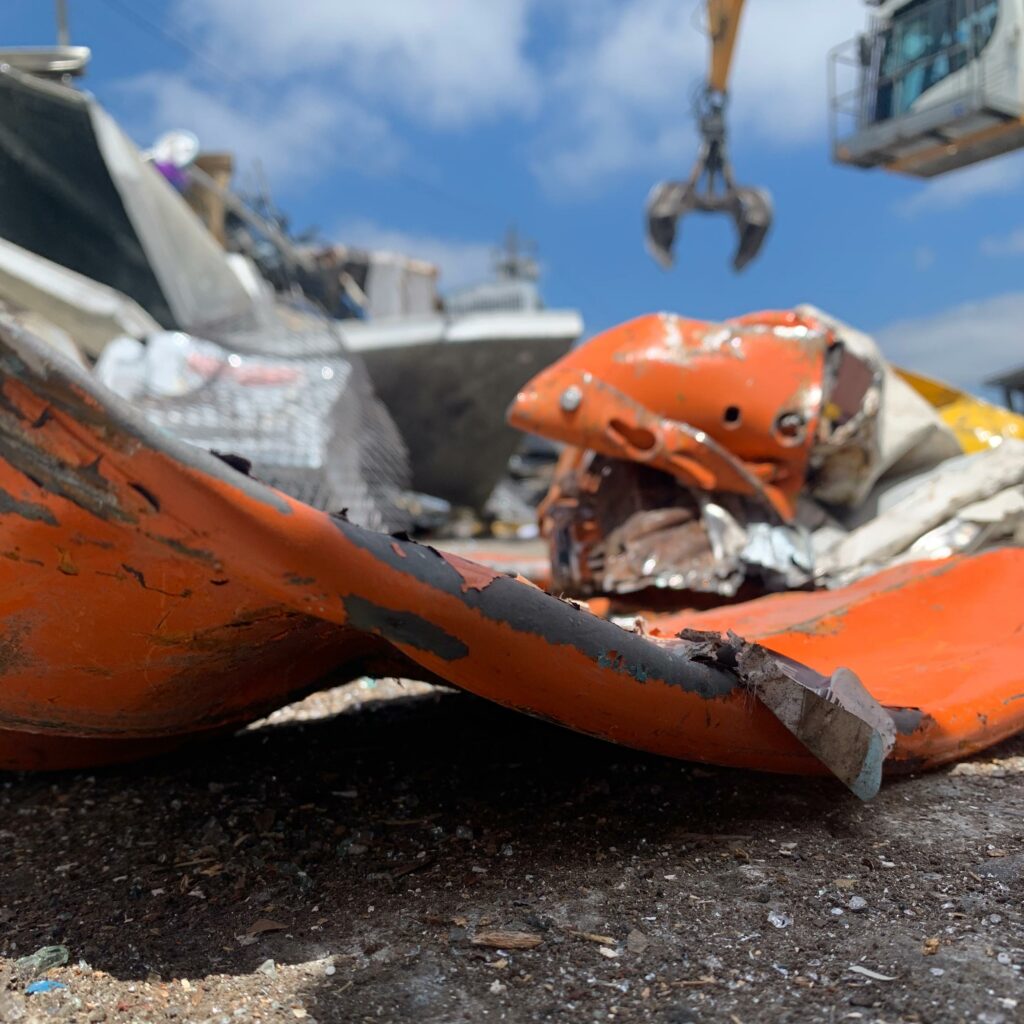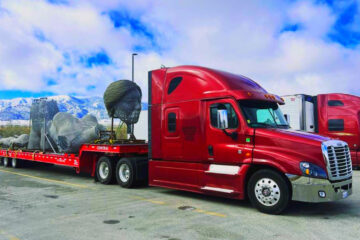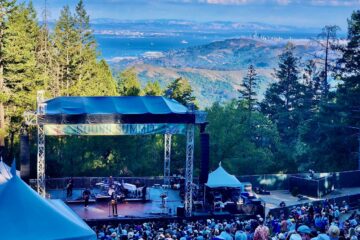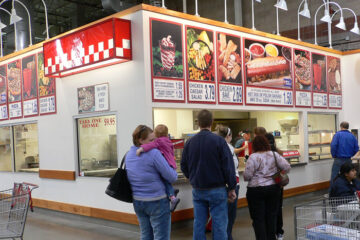Artist You Should Know: Brian Enright, Industrial Reuse Sculptor
Brian Enright is a working artist and sculptor who creates artwork out of unconventional recycled materials. He designs work that helps you see the connection between yourself and the natural world; objects that start a conversation. Through my interview with him, you’ll learn where he gets his materials (via an epic adventure we went on) and how he sees art as being a true connection point between people and stories.
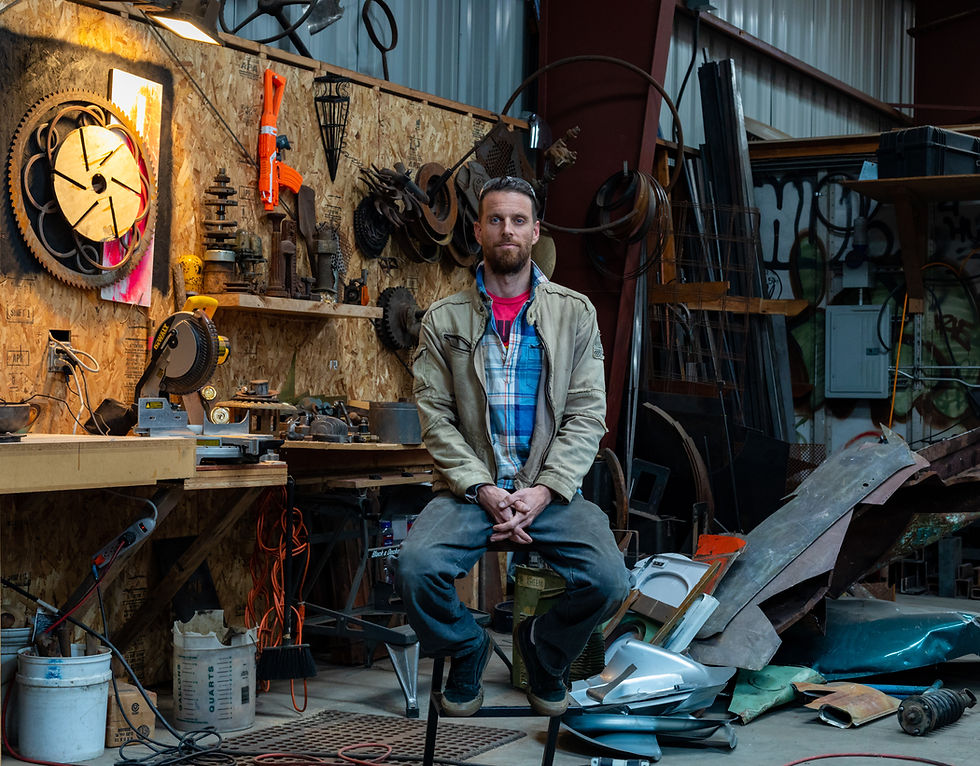
Portrait of Brian Enright in his shop space – photo by @jahsaudi
Enright works out of Seaport Studios, a new co-working space in Richmond. You may remember when I did a feature on them? Well, when I went over to Seaport Studios a few months back, I met a lot of the artists face-to-face for our interviews. I was able to view their work and see some of their processes. If I were to be the type of writer who specializes in novels, Seaport artists could all have a minimum of two chapters each. Their skills are awe-inspiring and their stories are profound, touching, and (as an artist myself) motivating.
The day I toured Seaport Studios, Brian Enright was absent. I knew a little bit from the interview questions he sent over but I had seen some of his work (like the feather pictured above) and I just knew he was someone we all needed to know better.
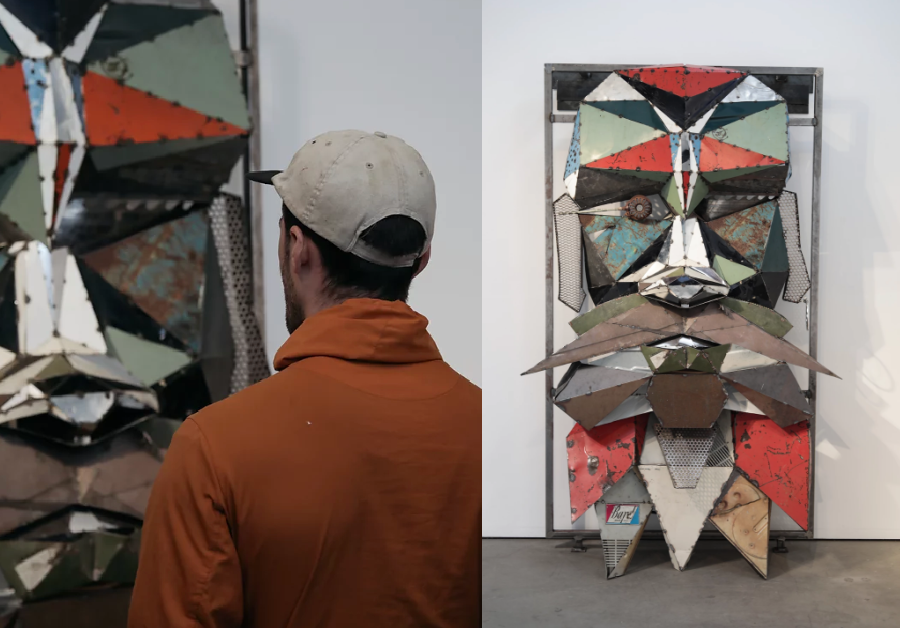
The Assembled God by Brian Enright is made of scrap metal, saw blades, structural steel. 62x99x24” – photos by @jahsaudi
Using objects to connect their rich stories of the past to present reality
Enright’s love for repurposing materials started when he was living up in Alaska, well before he came back to the Bay Area. When you live out in the middle of nowhere, you have to use what you have. You find yourself discovering new ways to use things just so you don’t have to make that long trek into town. This is exactly how Enright started his adventure into the adventures of reusing materials.
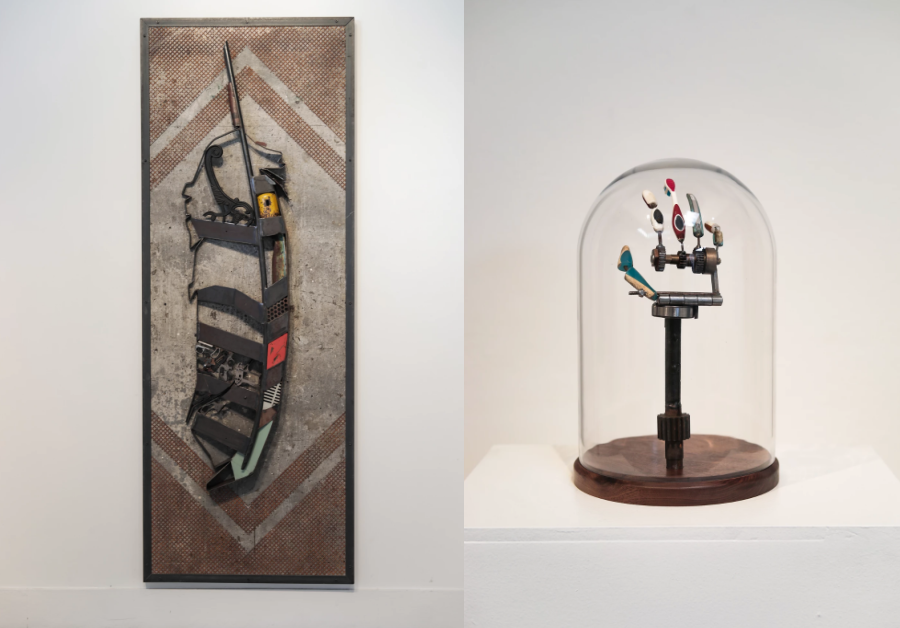
Sculptures by Brian Enright – “Blessing” (left) is made of scrap metal, found wood, blacksmithed steel, confiscated weapons, saw blades. “Sacrifice” is made of toothbrushes, found gearing, walnut and glass cloche – photos by @jahsaudi
As he puts it, “there’s a cause and effect” to everything we do. Using something just once creates waste and there’s an impact on the environment when you do that. Repurposing something gives it more life – more meaning.
“I make things out of things. I work with metal, wood, found objects, and historic artifacts. My art is about the interconnectedness of all life, our actions, and the law of cause and effect. I know it is right when the piece looks like it is an artifact either from the distant future or out of the mythic past. My current work envisions and creates new mythology around our relationship to the single-use pandemic and the trash of our world. All objects – still in use or thrown away ages ago – have an inherent story to them. Weaving these objects together connects their stories to the present reality and a new vision of our future,” says Enright.
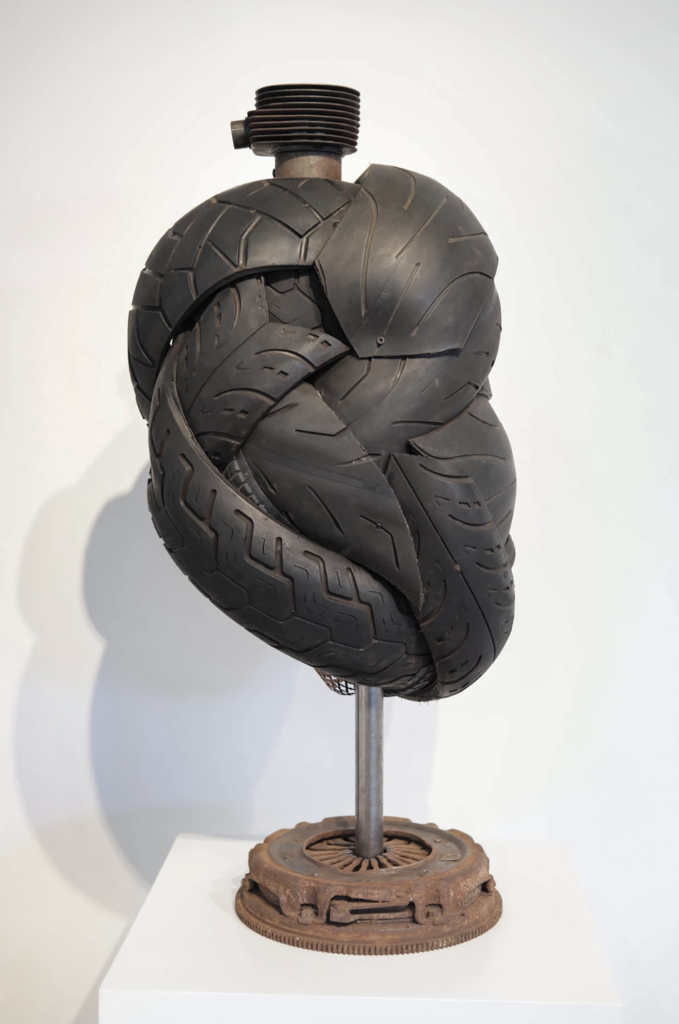
“Drive” by Brian Enright: Automotive and Vespa parts, motorcycle and bicycle tires, Oak trunk – photo by @jahsaudi
Making “things out of things” oversimplifies the work that Enright does. He pulls apart tires, reimagines steel parts, connects different textures of metal to create layered interest, and combines materials that you wouldn’t think would ever go together – he does all of this with an ease that isn’t second nature to folks. But he stays humble and that’s what makes him such an approachable person.
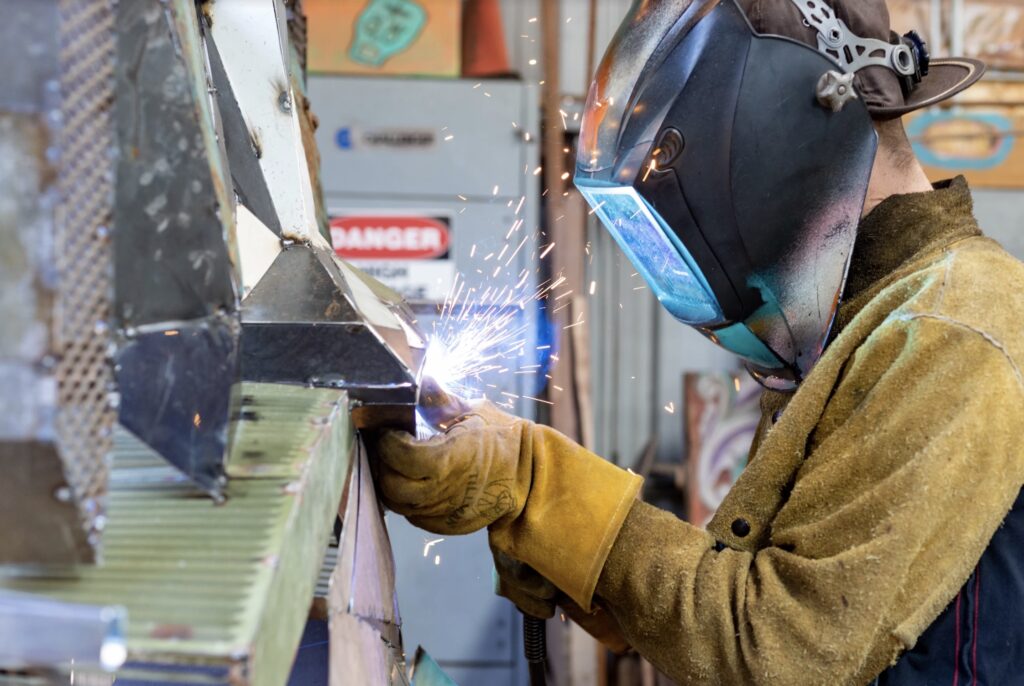
Brian Enright working on one of his sculptures – photo by @jahsaudi
Adventuring with artist Brian Enright to gather materials for an upcoming show
Since I missed out on a face-to-face interview when I first came to Seaport Studios, way back when, I came back to Enright and asked if he wanted to connect. After getting to know him from afar, I was curious about his process and where and how he gets the materials for his artwork.
To my delight, he said we could go on a material gathering adventure! When I tell you I nearly fell over in happiness, I’m not lying. Where were we headed? CASS in West Oakland. They call themselves a “closed loop-recycling and manufacturing company”. In short, the recycling center in Oakland is where you can drop off your recycling. Enright has a unique relationship with CASS. He’s able to, by appointment only, come by and gather materials that he can use in his sculpture work.
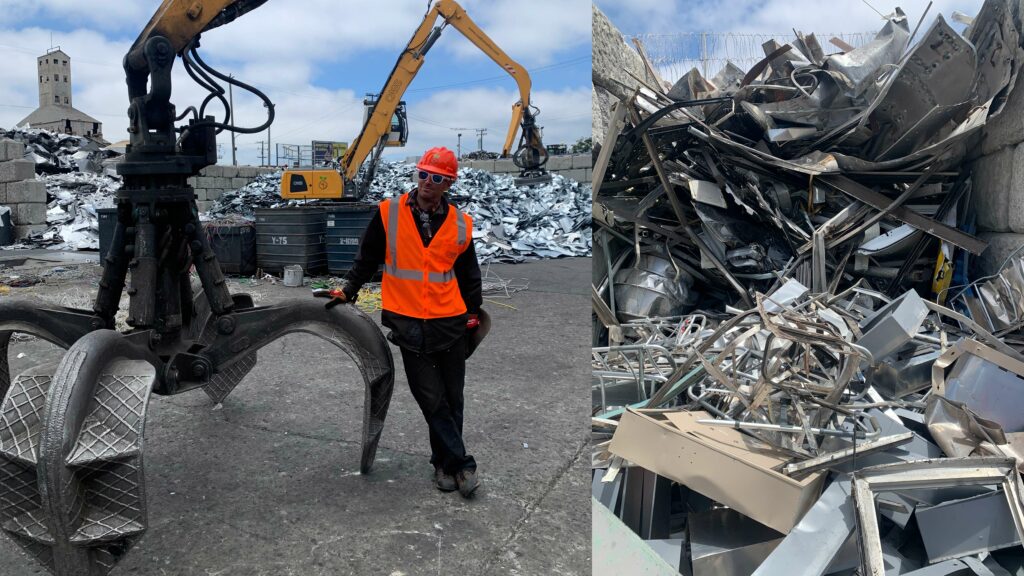
Brian Enright – 100% comfortable roaming around a CASS for materials, clearly – photo by Katy Atchison
Enright is working on a new body of work for an upcoming exhibit. His vision for this next series has a beautiful story about rebirth. He asked if I’d like to join him to find materials specifically that were in the color of butterflies and I was SO EXCITED that I got the dates wrong and went to meet up with him a week earlier than planned. Whoops!
When I finally got my calendar straight and met up with him we had the most epic adventure at CASS, a recycling center in West Oakland, CA.
Our adventure started by signing into the front desk and getting a hard hat along with an orange visitor vest from reception. From there, we were escorted by a part of the CASS team around the facility. You see, you can’t just step onto the property and grab what you need. You must always be escorted – mostly for safety. Hannah, our “tour guide” would periodically call up to the crane operators so that they would stop working while we were nearby. This usually happened when Enright would spot a piece of metal in a massive heap of discarded recycled metal.
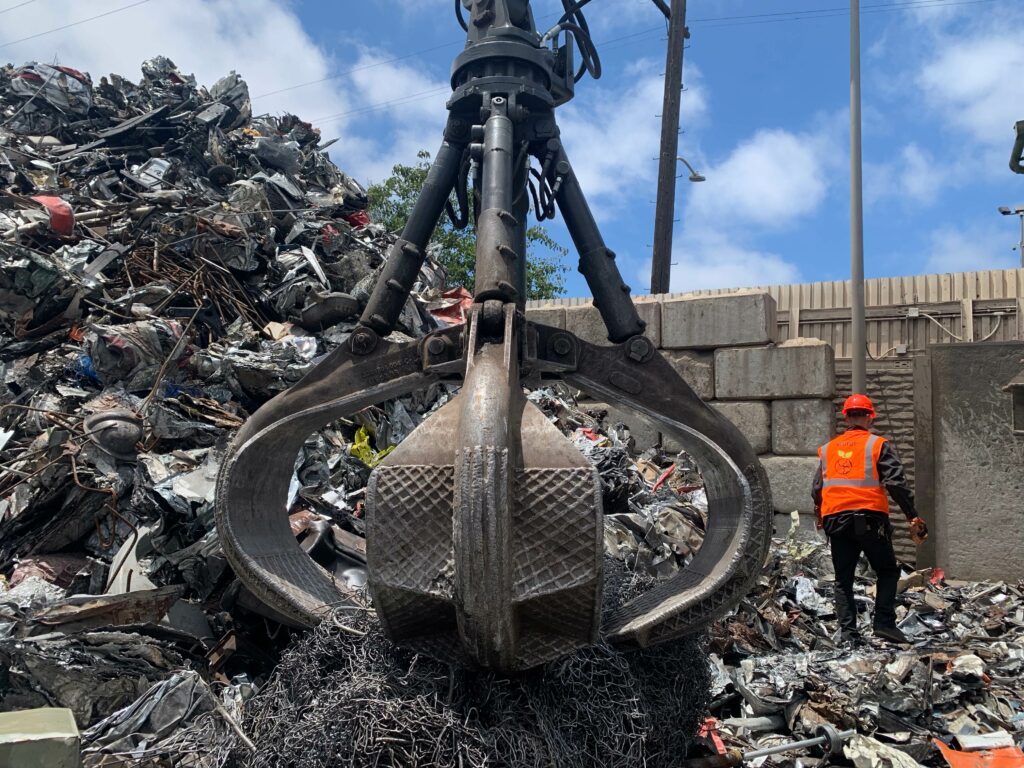
Photo of Brian Enright walking through piles of scrap metal while the crane operator stops and waits patiently for him to finish – photo by Katy Atchison
The space at CASS felt both completely unorganized and perfectly organized in the facility at the same time. These piles that he was sifting through were nearly two stories high. If there was something Enright couldn’t reach or it was too heavy for him to carry, Hannah would call over and have someone lift it for us with a forklift or other heavy equipment.
It was such an inspiring place to find materials. Sure, it might seem weird to sort through discarded material (also called garbage to most folks), but watching Enright sort through the piles upon piles of goods was super interesting. From piles and piles of seemingly endless amounts of metal, he ended up with colors of metal that were the colors of a monarch butterfly. That was such a cool thing to see – a brightly colored palette that came out of a sea of scrap metal.
When asked about what would happen to the materials next, Enright told me that he’d bring them back to his studio and start pulling them apart to make different pieces of the final sculpture. That’ll need to wait until after some other projects are done but we’re anxiously awaiting photos of the piece in the process once he gets started. He’ll likely post about the process on his Instagram if you’re curious.
As for CASS and whether you can go there any time you want to get materials. The short answer is that artists are allowed to come and gather supplies. However, it’s not that simple. You need to contact the facility, get permission, and set up an appointment. However, they believe “Sustainability is a fundamental part of who we are and what we do.” Therefore, they encourage artists to use recycled materials when they can to keep things out of landfills.
The folks at CASS want to spread a message of sustainability and reuse. Our guide Hannah was nudging Enright to take more things. The more things he takes, the more things that could be reused. It’s interesting to think that all of the junked metal we picked up is something that no one wanted anymore. It was seemingly only worth what it weighed in at when coming into CASS as scrap metal. At one point, this object may have come out of a factory looking like 10,000 of the same thing. Now, it features scraps and dents that tell a story of what happened along this object’s journey.
While we packed things into Enright’s truck at the end of our adventure with Hannah at CASS, we talked about the colors, the beauty in the textures and how these pieces of scrap would be transformed from something unwanted into something wanted and treasured.
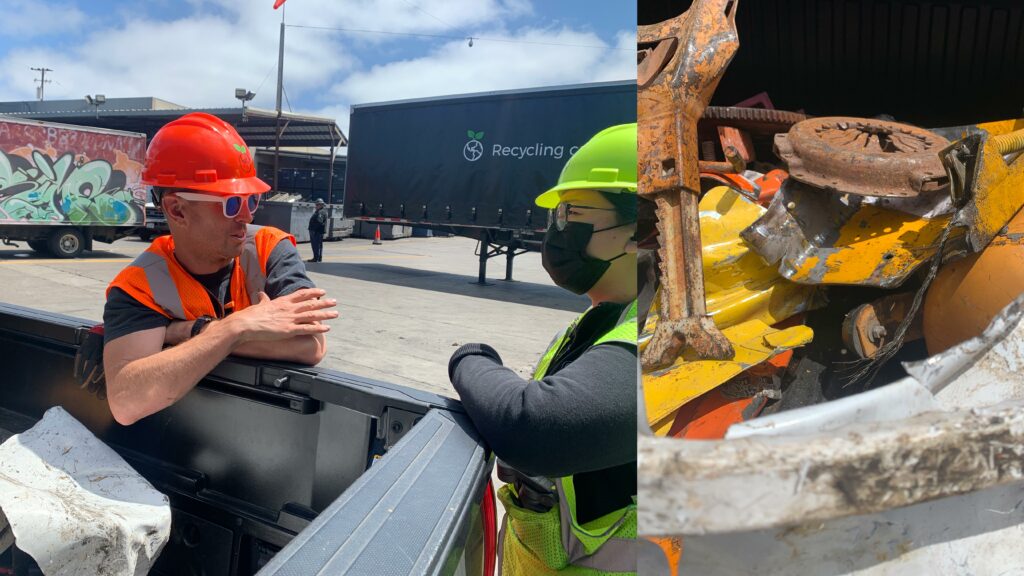
Sculptor Brian Enright talking with our CASS guide, Hannah, about how she might be able to use materials in her own work. To the right, his score from our CASS trip – photos by Katy Atchison
For Brian Enright, all art can be a conversation starter: a statement
Through anything that he makes, Enright wants you to approach him and connect with his work. He has something to say and he hopes you’ll listen. His work starts a conversation. About how something that was once ugly and unwanted can become beautiful and treasured. He believes that art can connect people and when he talks to you about his feeling about it, you believe him wholeheartedly.
“I would encourage everyone to connect with artists. Talk with them, ask them questions about their work or their life or whatever. Buy their work or don’t buy their work, but join in the conversation of what art itself is speaking to. Connect with that story. It is about this very moment, and about where we are going. Art is more important than you think.”
It’s true. Art can have a message and most art does. It can be as simple as a short message to bring you joy or it can make you think about the larger meaning behind it. That’s something I enjoy about art myself. That multi-layered story that someone is trying to communicate with you, their emotions tied up in string, painted on a canvas, or plastered onto an object.

Re:Tree by Brian Enright features wood taken from trees downed during the Sonoma County fires – photos by @_trashythom_
Enright hopes he can inspire others to connect to a larger story through art. He wants people to see the hidden power of repurposing items and creating objects out of unwanted materials themselves.
In a recent piece, “Re:Tree”, he used downed trees from the Sonoma County fires. The materials themselves found within Enright’s work evoke a feeling of connection between yourself and the artwork. For me, this piece of art symbolizes climate change and the push and pull between our industrial society and nature.
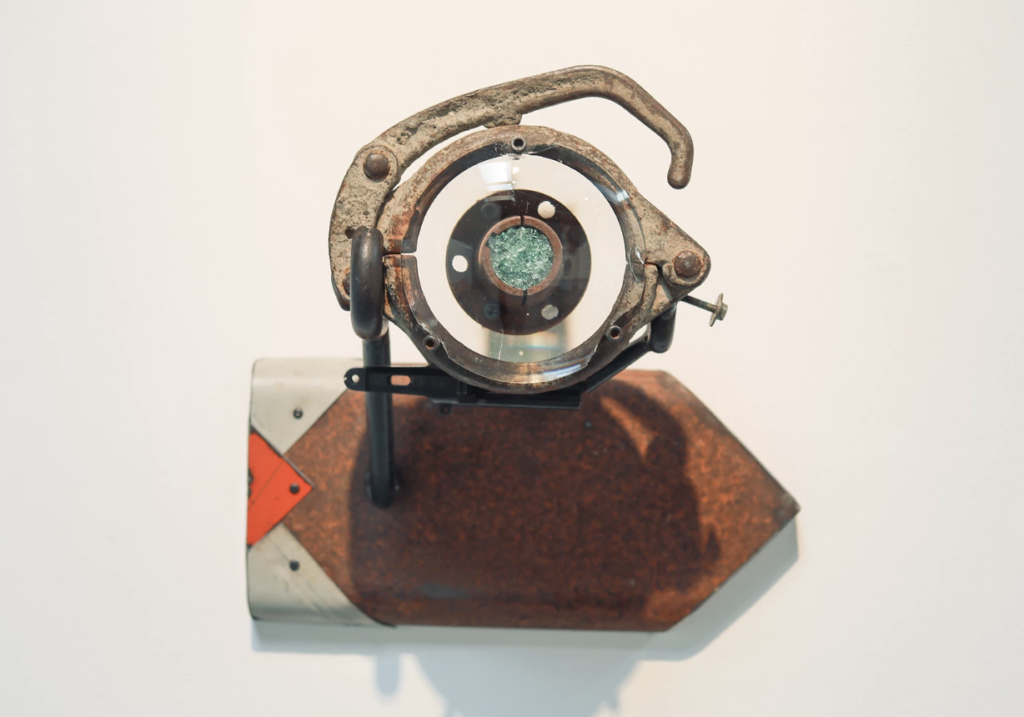
“Insight” by Brian Enright is made of scrap metal, found lens, broken auto glass and saw blades – photo by @jahsaudi
Enright is a true working artist, and he’s proof that a person can make a living doing what they love. He feels it’s possible for anyone to if you put your mind to it. It won’t be easy and there will be bumps along the way. However, if you have a message you want to get out into the world through your art, dive in and get creating.
“If you are hoping to make a living doing what you love that is great. That is what I do. But recognize that it will most likely take much longer than you expect it to. So much longer than all your friends who are in more traditional jobs or working for a company. As an artist, you become every person at the company. And if you are not good at something, (because no one is good at everything) then you are going to have to learn it or spend the money to have someone else do it for you. You are becoming an entrepreneur and business owner whether you want to or not.”
To learn more about Brian Enright, visit his website and follow him on social media:
Brain Enright’s work is currently on display at The Randall Museum in San Francisco through August.
Brian Enright’s Website: https://www.enrightsculpture.com/
Instagram: @enrightsculpture
Brian teaches welding at The Crucible in West Oakland
And is also one of the artists behind Engineered Artworks.
Enright closes with a quote from a poet, and a mentor of his in both art and life:
“The life and essence of art–whether it be painting, music, or dance–lies in expressing through a wellspring of emotion the universal realm of the human spirit. It is a melding of the individual and the universal. That is why great art reaches out beyond ethnic and national barriers to move people all over the world.” – Daisaku Ikeda”
*all images are property of Brian Enright unless otherwise noted


